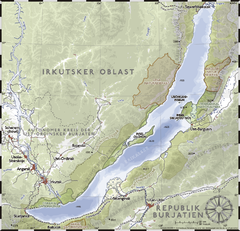Lake Baikal: Freshwater rift lake in southern Siberia, Russia
Lake Baikal is a huge lake in Siberia, Russia.
It is the biggest fresh water reservoir in the world. The lake is near Irkutsk.
| Lake Baikal | |
|---|---|
 | |
 | |
| Coordinates | 53°30′N 108°0′E / 53.500°N 108.000°E |
| Lake type | Continental rift lake |
| Primary inflows | Selenge, Barguzin, Upper Angara |
| Primary outflows | Angara |
| Catchment area | 560,000 km2 (216,000 sq mi) |
| Basin countries | Russia and Mongolia |
| Max. length | 636 km (395 mi) |
| Max. width | 79 km (49 mi) |
| Surface area | 31,722 km2 (12,248 sq mi) |
| Average depth | 744.4 m (2,442 ft) |
| Max. depth | 1,642 m (5,387 ft) |
| Water volume | 23,615.39 km3 (5,700 cu mi) |
| Residence time | 330 years |
| Shore length1 | 2,100 km (1,300 mi) |
| Surface elevation | 455.5 m (1,494 ft) |
| Frozen | January–May |
| Islands | 27 (Olkhon) |
| Settlements | Irkutsk |
| 1 Shore length is not a well-defined measure. | |
Baikal is about 636 km (395 mi) long. It is 20 to 80 km (12 to 50 mi) wide. At its deepest point, it is 1,700 m (5,600 ft) deep. It is the deepest lake on Earth. The lake is a UNESCO World Heritage Site. It holds about 20% of the world's unfrozen surface fresh water.
The lake has unique fish. It is home to more than 1,700 species of plants and animals. Two-thirds of them can be found nowhere else.
Geology

Lake Baikal fills an ancient rift valley, just as Lake Tanganyika does in East Africa. At the Baikal Rift Zone, the Earth's crust pulls apart.
It is the deepest lake in the world at 1,642 m (5,387 ft). The bottom of the lake is 1,186.5 m (3,893 ft) below sea level, but below this lies some 7 km (4.3 mi) of sediment. This means the rift floor is 8–11 km (5.0–6.8 mi) below the surface: it is the deepest continental rift on Earth.
In geological terms, the rift is young and active – it widens about two cm per year. The fault zone is also seismically active; there are hot springs in the area and notable earthquakes every few years.
Baikal's age is 25–30 million years. It is unique among large, high-latitude lakes, because its sediments have not been scoured by overriding continental ice sheets. U.S. and Russian studies of core sediment in the 1990s gave a detailed record of climatic variation over the past 250,000 years. Longer and deeper sediment cores are expected soon. Lake Baikal is the only confined freshwater lake in which evidence of gas hydrates exists.
The lake is completely surrounded by mountains. The Baikal Mountains on the north shore and the taiga are protected as a national park. It has 27 islands; the largest, Olkhon, is 72 km (45 mi) long and is the third-largest lake-bound island in the world. The lake is fed by as many as 330 inflowing rivers. It is drained through a single outlet, the Angara River.
Despite its great depth, the lake's waters are well-mixed and well-oxygenated throughout the water column, compared to the stratification that occurs in such bodies of water as Lake Tanganyika and the Black Sea.
Wildlife

Lake Baikal has over 1000 species of plants and 1550 species and varieties of animals. Over 60% of animals are endemic; of 52 species of fish 27 are endemic.
The omul fish (Coregonus autumnalis migratorius) is local to Lake Baikal. It is fished, smoked, and sold on all markets around the lake. For many travellers on the Trans-Siberian railway, purchasing smoked omul is one of the highlights of the long journey.
Baikal also has a species of seals, Baikal seal or nerpa. Bears and deer can be seen and hunted by the Baikal coast.
Ecosystem
In 1986 Baikalskyi and Barguzinskyi became Biosphere Reserves. The ecosystems are part of UNESCO's Man and the Biosphere (MAB) Programme.
Ecodangers
The Baykalsk Pulp and Paper Mill was constructed in 1966 on the shoreline of Lake Baikal. The plant bleached paper using chlorine and discharged waste directly into Lake Baikal. The decision to construct the plant at Lake Baikal resulted in strong protests. The objections of Soviet scientists had opposition from the industrial lobby. Only after decades of protest was the plant closed in 2008 (and only because it was unprofitable). On 4 January 2010, production was resumed. On 13 January 2010, Russian President Vladimir Putin legalised the operation of the plant. This brought a wave of protests from ecologists and local residents. In September 2013 the mill went bankrupt.
Related pages
- List of World Heritage Sites in Russia
- Marina Rikhvanova, an ecologist who works to protect Lake Baikal
References
Other websites
 Media related to Lake Baikal at Wiki Commons
Media related to Lake Baikal at Wiki Commons
This article uses material from the Wikipedia Simple English article Lake Baikal, which is released under the Creative Commons Attribution-ShareAlike 3.0 license ("CC BY-SA 3.0"); additional terms may apply (view authors). Content is available under CC BY-SA 4.0 unless otherwise noted. Images, videos and audio are available under their respective licenses.
®Wikipedia is a registered trademark of the Wiki Foundation, Inc. Wiki Simple English (DUHOCTRUNGQUOC.VN) is an independent company and has no affiliation with Wiki Foundation.